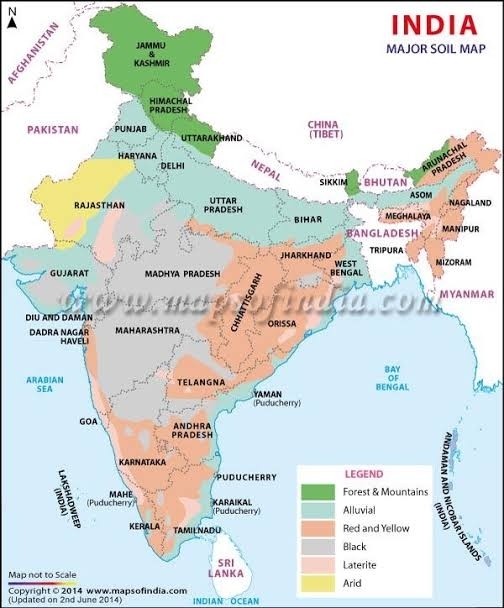Different soil types in India: Understand the differences
- Alluvial soils
- Black (or Regur soil)
- Red and Yellow soils
- Laterite soils
- Arid and desert soils
- Saline and alkaline soils
- Peaty and marshy soils
- Forest and mountain soils
Types of Soils | States where found | Rich in: | Lacks in: | Crops grown |
| Alluvial | Mainly found in the plains of Gujarat, Punjab, Haryana, UP, Bihar, Jharkhand etc. | Potash and Lime | Nitrogen and Phosphorous | Large variety of rabi and kharif crops such as wheat, rice, sugarcane, cotton, jute etc. |
| Black (Regur soil) | Deccan plateau- Maharashtra, Madhya Pradesh, Gujarat, Andhra Pradesh,Tamil Nadu, Valleys of Krishna and Godavari. | Lime, Iron, Magnesia and Alumina, Potash | Phosphorous, Nitrogen and organic matter | Cotton, sugarcane, jowar, tobacco, wheat, rice etc. |
| Red | Eastern and southern part of the deccan plateau, Orissa, Chattisgarh and southern parts of the middle Ganga plain. | Iron and Potash | Nitrogen, Phosphorous and humus. | Wheat, rice, cotton, sugarcane and pulses |
| Laterite | Karnataka, Kerala, Tamilnadu, Madhya Pradesh, Assam and Orissa hills. | Iron oxide and potash | Organic matter, Nitrogen, Phosphate and Calcium | Cashewnuts, tea, coffee, rubber |
| Arid and Desert | Western Rajastan, north Gujarat and southern Punjab | Soluble salts, phosphate | Humus, Nitrogen | Only drought resistant and salt tolerant crops such as barley, rape, cotton, millets maize and pulses |
| Saline and Alkaline | Western Gujarat, deltas of eastern coast, Sunderban areas of West Bengal, Punjab and Haryana | Sodium, Potassium, Magnesium | Nitrogen and Calcium | Unfit for agriculture |
1. Alluvial Soil

- Alluvial soil constitutes of 42 % of the total soil area in India.
- It is formed as a result of deposition of rivers and thus it is more fertile and rich in organic material.
- Alluvial Soil is found in plenty in the states - Uttar Pradesh, West Bengal, Bihar, Odisha, Punjab, Haryana and Brahmaputra Valley in Assam etc. of India.
- Alluvial Soil is best for crops like - Wheat, Rice, Cotton, Jute, Barley, Corn, Oilseed, Coffee, Potatoes, Chili, Cloves etc.
2. Black Soil

- Black soil constitutes of 15% of the total soil area in India.
- It is formed as a result of weathering of lava rocks of Deccan plateau and thus rich in Iron, magnesium, Silica, Lime and potash.
- It has high clay content and has high water retaining property.
- Black Soil is found in plenty in the states - Maharashtra, Gujarat, Andhra Pradesh, Karnataka, Rajasthan, Tamil Nadu, Uttar Pradesh.
- Black Soil is best for crops like - Mulberry Cotton Plant Ground Nut, Chili, Cotton, Tobacco, Chili, Oil Seeds, Jowar, Ragi, Maize, Castor, Sugarcane, Safflower etc.
3. Red Soil

- Red soil constitutes 25 % of the total soil area in India and is the most widely spread soil.
- It is formed a s a result of erosion of Granite and Gneissic rocks.
- It is rich in Iron, phosphate, lime, potash and humus and supports wide crop diversity.
- Major areas of Red soil in India is - Andhra Pradesh, Karnataka, Kerala, Tamil Nadu, Telangana, Puducherry, Rajasthan, Madhya Pradesh, Gujarat, Goa, Arunachal Pradesh, Assam, Manipur, Meghalaya, Nagaland, Mizoram, Tripura, Delhi, Uttar Pradesh, Himachal Pradesh.
- Red Soil is best for crops like - Cotton, Wheat, Pulses, Tobacco, Jowar, Linseed, Millet, Potatoes and Some Fruits etc.
4. Laterite Soil

- Laterite soil constitutes 4.5 % of the total soil area in India and is the most acidic soil.
- It gets quickly eroded on deforestation, mining and plantation.
- It is not suitable for agriculture but suitable for special crops like tapioca and cashew.
- Major areas of laterite soil in India is Maharashtra, Andhra Pradesh, Tamil Nadu, Karnataka, Meghalaya, West Bengal .
- Laterite soils is best for crops like Tea, Coffee, Coconuts, Rice, Wheat, Cotton, Maize, Sugarcane, Jute Oil Seeds, Millets, Pulses etc.
5. Mountain Soil

- Mountain soil is a thin layer of soil formed under cold humid climate.
- It is not suitable for agriculture but suits best for forestry.
- The humus content is high in this soil due to the climate.
- Major areas of mountain soils in India are - Jammu & Kashmir, Himachal Pradesh, Arunachal Pradesh, Sikkim, Assam.
- Mountain Soil is best for crops like Coffee, Tea, Wheat, Maize, Blueberries, Saffron etc.
6. Saline and Alkaline Soil

- Saline-Alkaline soil is found in canal areas.
- In moderate arid condition, calcification occurs and in extreme arid conditions, salinity occurs.
- Major areas of Saline and Alkaline soils in India are - Rajasthan, Uttar Pradesh, Bihar, Haryana, Punjab, Maharashtra etc.
- The soil is best for crops like Seem, Rice, Sugarcane, Fruits, Spices etc.
7. Desert Soil

- Desert soil is sandy and loose soil.
- Due to its coarse structure, the water holding capacity is very less.
- As it has low nutrients, it is not suitable for agriculture.
- Major areas of Desert soils in India are -Rajasthan, Gujarat, Haryana, Punjab
- The soil is best for crops like Xerophytes only.
8. Peaty and Marshy Soil

- These are black coloured, heavy and highly acidic soils.
- When the vegetation growing in such wet places dies, it decomposes and a layer of partly decayed organic matter accumulates on the surface, giving rise to such peaty and marshy soils.
- Major areas of Peaty and Marshy soils are - Kerala, Odisha, Tamil Nadu, West Bengal, Bihar, Uttaranchal.
- This soil is best for crops like Rice, Oilseeds, Citrus, Tobacco, Sugarcane etc.

Comments
Post a Comment